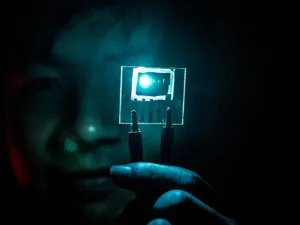A team from the University of Michigan (U-M), led by Stephen Forrest, a professor of Electrical and Computer Engineering, has made an advance in OLED technology by developing a new type of blue PHOLED.
The U-M team’s blue PHOLEDs are designed to maintain 90% of their blue light intensity for a duration 10-14 times longer than current models that emit similar deep blue colors. This improvement is a crucial step towards meeting the Department of Energy’s 50,000-hour lifetime target for OLED lights.
Currently, these blue PHOLEDs are suitable for lighting applications. However, the team believes that the same design principle could be adapted for use in TVs, phone screens, and computer monitors. Devices with blue PHOLED displays could potentially see up to a 30% increase in battery life.
For over 20 years, the pursuit of long-lived blue PHOLEDs has been a significant challenge in the field of organic electronics. Prior to this research, blue PHOLEDs were not durable enough for use in lighting or displays, leaving only red and green PHOLEDs in practical use. Blue light is essential to complete the RGB color range in OLED displays and white OLED lights.
The innovative approach taken by the U-M team involves a complex interplay of materials and optical engineering. To generate blue light, the technology relies on exciting heavy metal-containing phosphorescent organic molecules. In addressing the inherent problem of high-energy blue light causing rapid material degradation, the team developed a novel structure. They sandwiched cyan-emitting material between two mirrors, finely tuning the gap to selectively enhance deep blue wavelengths. This structural design ensures that only the desired deep blue light waves are sustained and eventually emitted, a critical factor for achieving the targeted color purity and efficiency.
Furthermore, the researchers optimized the optical properties of the organic light-emitting layer adjacent to a metal electrode, introducing a new quantum mechanical state known as a plasmon-exciton-polariton (PEP). This state is characterized by the synchronization of excited states in the electron-transporting material with light waves and electron vibrations in the metal cathode. The presence of the PEP state accelerates the emission of light, effectively reducing the likelihood of excited states colliding and causing degradation. This quantum mechanical innovation is key to the enhanced durability and efficiency of the blue PHOLEDs.
This research, funded by the U.S. Department of Energy and Universal Display Corp (UDC).
Reference
Zhao, H., Arneson, C.E., Fan, D. et al. Stable blue phosphorescent organic LEDs that use polariton-enhanced Purcell effects. Nature (2023). https://doi.org/10.1038/s41586-023-06976-8

